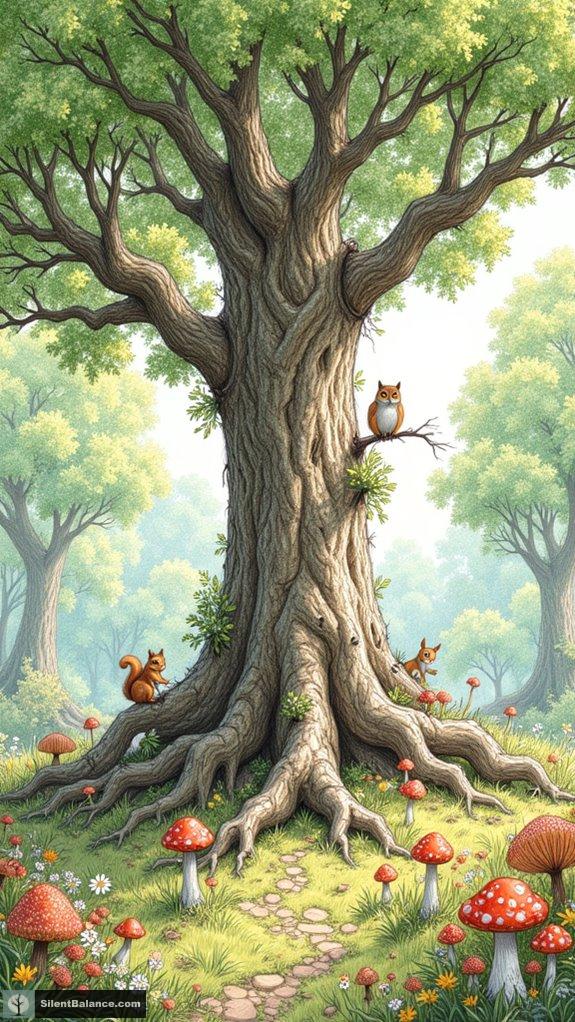The Secret Life of Trees: Messages in the Forest
In forests, trees communicate in incredible ways. They warn one another of dangers, share nutrient resources, and even call in beneficial predators against herbivores. Who knew trees could be social butterflies? This symphony of communication strengthens the entire ecosystem.
I still remember hiking in an ancient forest, feeling the rich symbolism of trees surrounding me. It was there my passion for their hidden languages blossomed. Our blog, Silent Balance, dives deep into this remarkable topic, illuminating the beauty of forest connections.
One afternoon, I spotted a wounded deer. Nearby, trees seemed to whisper messages to one another. Their branches swayed gently, perhaps warning their neighbors. I stood mesmerized, realizing how intertwined everything truly is. Nature’s voices were loud and clear, echoing a truth I’d later share in Silent Balance. Trees may look stationary, but they pulse with life!
Quick Takeaways
- Warning signals involve chemical messages like pheromones and volatile compounds to alert neighboring plants of herbivore threats.
- Resource sharing occurs through mycorrhizal networks, allowing trees to exchange nutrients and support younger trees in challenging conditions.
- Herbivore defense mechanisms are activated by chemical cues, prompting neighboring plants to enhance their defenses and attract predatory insects.
- Mycorrhizal networks also foster collaboration among various tree species, reducing competition and promoting ecosystem resilience.
- Chemical signaling, including phytohormones and root exudates, plays a critical role in plant survival and community interactions.
Warning Signal Messages in Forest Networks
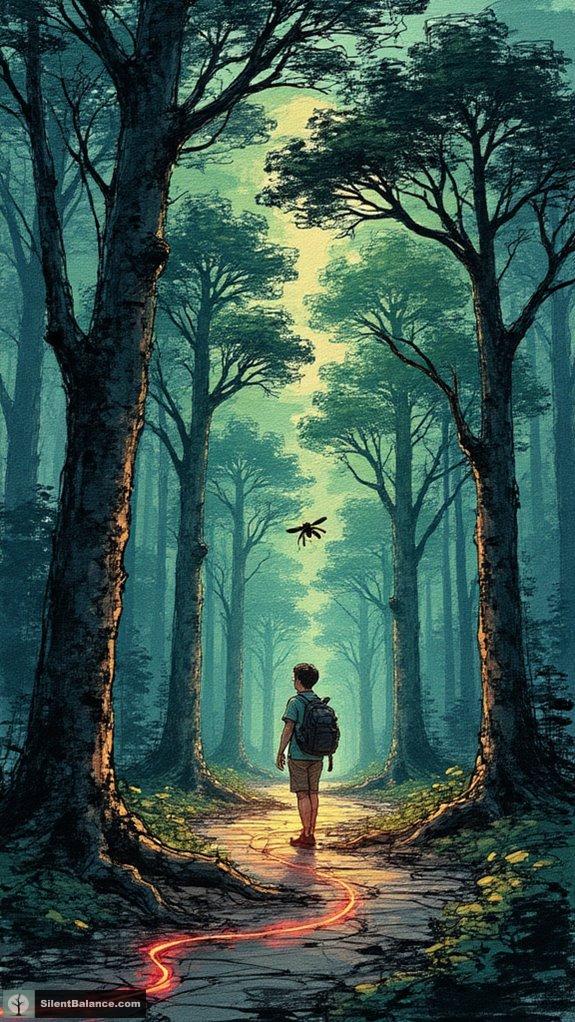
When it comes to warning signal messages in forest networks, you’ll be amazed at how plants communicate, almost like they’re whispering secrets through the roots and air.
Imagine a tree catching the faint scent of herbivore saliva and instantly sending out pheromones to summon parasitic wasps for a little extra muscle. Cool, right?
These signals—like ethylene gas from acacia trees—can trigger neighbors to pump up their defenses, spitting out tannins like tough guys. This interconnectedness reflects the role of mother trees as they facilitate communication and resource sharing among various plant species.
But that’s just the tip of the iceberg!
Chemical signals travel through underground mycorrhizal networks, creating a fierce community vibe. In just 24 to 50 hours, a warning spreads, setting off a chain reaction of defensive tactics in neighboring plants. Interestingly, this communication method may serve as an early indicator of broader biodiversity losses in forest ecosystems.
Next time you stroll through the woods, think of it as a network of plant chatter, all working together to stay alive and kickin’. Isn’t nature a wild ride?
Resource Sharing Messages Within Forest Networks
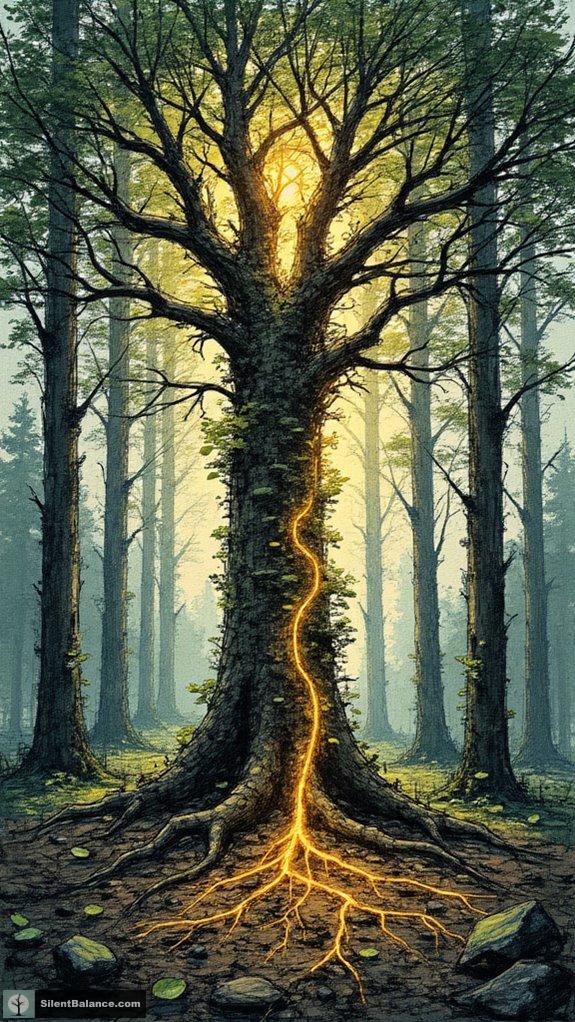
Envision wandering through a forest, where trees aren’t just standing tall and silent; they’re part of a bustling network of communication and camaraderie.
These trees, through mycorrhizal fungi, share resources like nutrients, carbon, and water—like forest buddies looking out for one another. Ever thought about how a larger “mother tree” might be sending support to its younger pals? It’s true! By sharing nutrients during tough times, like droughts, they boost not just their survival but also the entire community’s resilience. Mycorrhizal networks help to ensure that these connections thrive, highlighting the intricate bonds that enhance forest health. Fungal networks play a key role in maintaining this supportive environment among diverse tree species. Don’t you love how nature collaborates?
The complex fungal networks extend far, creating a communal vibe that fosters diversity instead of competition.
Herbivore Defense and Parasite Attraction Messages
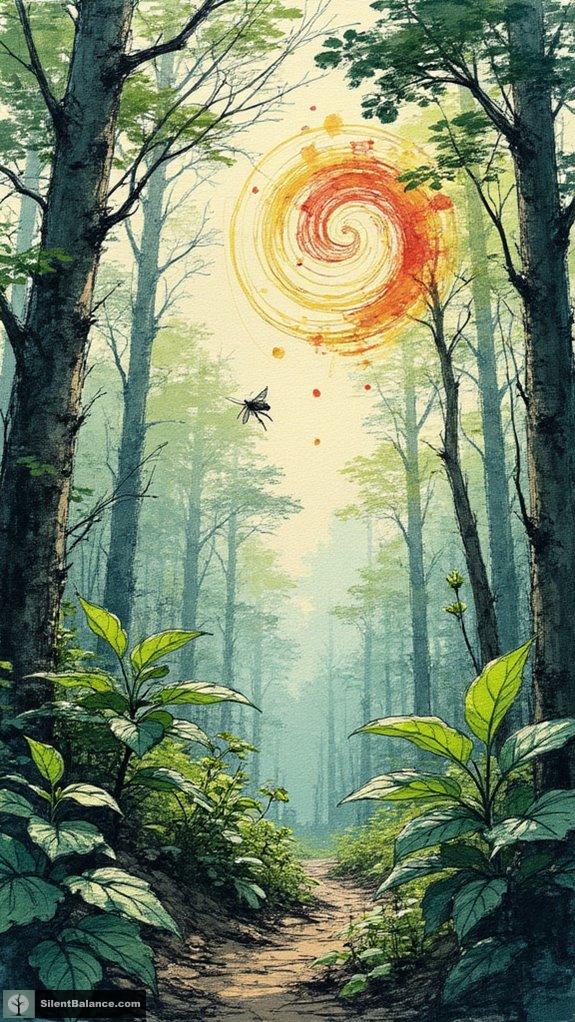
Plants have quite the survival game going on, don’t they? When hungry herbivores come knocking, they don’t just sit idly by; they release a powerful chemical SOS that warns their neighbors.
These volatile organic compounds, or VOCs, activate defense genes in nearby plants, gearing them up for battle. This process is not just a response; it involves epigenetic modifications that enhance the plants’ ability to defend themselves.
But it gets cooler. As the plants sound the alarm, they’re also dropping sweet hints in the form of extrafloral nectar, which attracts predators like parasitic wasps and predatory mites.
Talk about a team effort!
And guess what? The amount of these signals rises when herbivores are on a feast, which maximizes the plants’ defenses.
Science of Chemical Signaling and Message Types

When it comes to chemical signaling in forests, you’re really looking at a complex web of messages that plants use to communicate. From hormones that guide growth to volatile compounds that send signals flying through the air, these messages are essential for survival and interaction. Ever wonder how plants manage their relationships with soil microbes or even talk to their neighbors? This intricate process of chemical signaling helps ensure plant defense against pathogens and fosters a resilient ecosystem. Let’s jump into the fascinating world of chemical signals and uncover their roles in these lush ecosystems.
Chemical Signal Types
In the rich tapestry of forest ecosystems, chemical signals play a crucial role in orchestrating interactions among plants, animals, and their environment. They act as the secret messengers that communicate everything from danger to growth, shaping social dynamics in subtle ways.
- Phytohormones like auxin govern plant growth.
- Plant volatiles lure predatory insects during an herbivore attack.
- Alarm pheromones signal bees to defend their hive.
- Allomones repel predators or support pollination.
- Root exudates shape soil communities and plant partnerships. Feedback mechanisms, such as positive demographic feedback, enhance the resilience of these interactions within forest ecosystems.
Signaling Pathways Overview
Signaling pathways in forest ecosystems are like the complex graffiti that daubs walls in a city—each stroke telling a story, each pattern revealing a connection.
Envision each tree representing an independent route for messages, rooted at various cell surface receptors. You’ve got different signal transduction pathways flourishing, with the potential to uncover both known and novel processes.
Using cool tools like the PCSF algorithm, researchers can identify these pathways efficiently. It’s like a mapping session for all the hidden gems in the signaling world.
You wouldn’t want to miss the chance to explore how multiple pathways might harmonize or clash, just like art styles converging in one vibrant mural. Isn’t it exciting to ponder the discoveries waiting under the surface?
Importance of Communication
Ever notice how trees seem to have their own secret chat system going on? It’s all about chemical signaling, and it makes you appreciate the forest even more. These communication tactics aren’t just for show—they’re essential for survival!
- Trees emit volatile organic compounds (VOCs) as warning signs to neighbors.
- Mycorrhizal networks allow underground communication between different species.
- It’s not just chit-chat; these signals trigger defensive responses in nearby plants.
- They can even attract predator insects to protect the whole community.
- “Mother trees” link younger ones, coordinating responses like a true nature network.
Simply put, trees are like savvy networkers with a flair for teamwork, bonding over invisible messages that keep the forest thriving!
Mycorrhizal Network Message Types in Forests
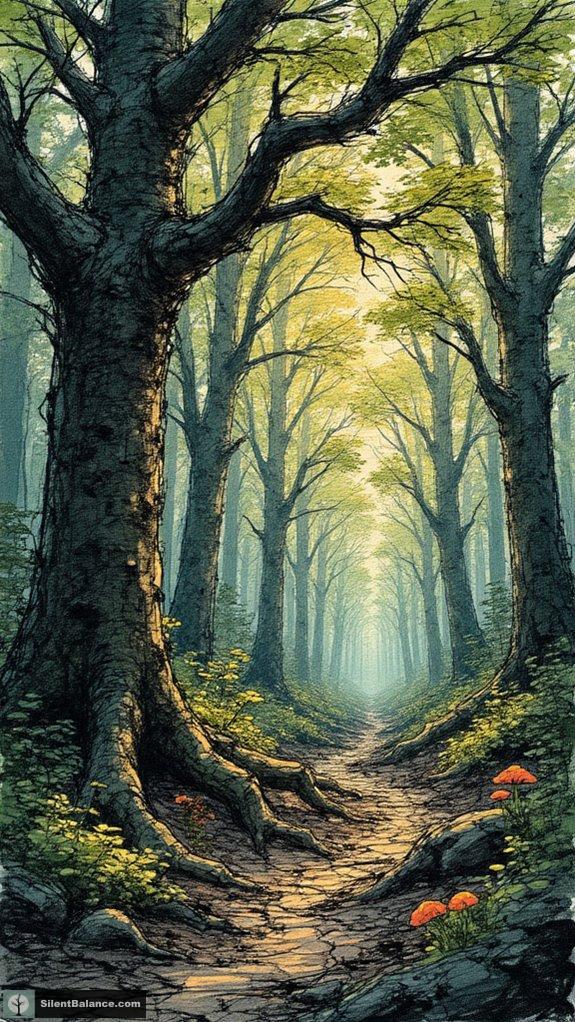
When trees connect through mycorrhizal networks, they tap into a hidden world of communication that’s as complex as a beautifully tattooed sleeve, filled with stories and connections.
Ever tried to warn a buddy about a bad ink session? Trees do the same! When pests attack, they send out chemical signals through those fungal networks, readying their neighbors for defense, like a well-timed alert in a bustling tattoo parlor.
But it’s not just about the warnings—these networks serve up essential resources too. Picture your tree pals sharing sugar and water, helping each other thrive in tough conditions, ensuring everyone gets a fair shot.
And let’s not forget the allelochemical vibes. Trees can flex their competitive edge or play nice, shaping the leafy community around them.
Questions and Answers
How Do Trees Identify Specific Threats in Their Environment?
Trees identify threats in their environment through a savvy mix of chemical whispers and electrical signals. They pick up on volatile compounds from nearby pals, alerting them to pests or diseases.
You’ve got those root networks chatting underground, sharing defense tips, and they even shift sap’s vibe when danger’s close. It’s like a forest-wide tattoo convention, where everyone’s inked with the latest survival tricks!
Who knew trees were so in the know?
Can Non-Native Species Participate in Forest Communication Networks?
Ever wondered if those colorful non-native species can actually chime in on forest chats?
You bet they can! Non-native plants and trees form their own alliances within forest ecosystems, interacting with both native species and each other.
Think of it as an urban tattoo parlor—everyone’s got their ink, but some designs influence the whole vibe.
What Specific Roles Do Different Mycorrhizal Fungi Play in Communication?
Different mycorrhizal fungi play essential roles in plant communication, connecting roots and sharing information. Ectomycorrhizal fungi create extensive networks among trees, while arbuscular mycorrhizal fungi work with herbaceous plants, helping them trade nutrients for sugars.
Ever wondered how trees warn each other about pests? It’s through these underground connections, shooting electrical signals and chemical cues like a hidden inked masterpiece beneath the soil.
They’re nature’s tattoo artists, crafting resilience and adaptability in the forest community!
How Does Climate Change Affect These Forest Communication Networks?
Did you know that climate change can shrink forest communication networks by favoring weaker fungi?
As temperatures rise and drought strikes, trees lose the carbon they share with their mycorrhizal buddies. You might wonder: what happens next?
These low-biomass fungi bring less to the table, simplifying complex connections. Less connection means poorer forest health, affecting everything from tree recruitment to nutrient cycling.
Are There Human-Made Technologies Inspired by Forest Communication Systems?
Think about how humans borrow from the natural world; we’ve crafted tech like IoT networks that mimic forest communication.
You’ve got low-power sensors, mesh networks, and satellite links, all echoing the interconnected vibes of trees exchanging nutrients.
It’s like ink on skin, flowing with stories—each line weaving into the next.
Isn’t it wild how we’re drawing inspiration from trees, not just for shade, but also for staying connected in this tech-driven age?
Summary
In the complex world of forest networks, messages flow like ink on skin, linking trees and life in a vibrant tapestry of communication. Whether it’s a warning, a resource share, or a call for herbivore defense, it’s fascinating to see how everything’s connected, right? It’s like the pulse of the forest, each message a heartbeat in this lush ecosystem. So, next time you wander through the woods, think about the silent conversations happening all around you!
References
- https://one-more-tree.org/blog/2025/04/04/what-do-trees-say-to-the-world-plant-communication-through-underground-mycorrhizal-networks/
- https://www.smithsonianmag.com/science-nature/the-whispering-trees-180968084/
- https://biofriendlyplanet.com/unveiling-the-hidden-communication-networks-of-forests/
- https://ecotree.green/en/blog/do-trees-communicate
- https://clas.ucdenver.edu/ges/common-mycelial-network-cmn-forests
- https://www.nature.com/articles/s41598-018-19985-9
- https://www.goodnet.org/articles/explore-amazing-social-networks-trees
- https://pmc.ncbi.nlm.nih.gov/articles/PMC4497361/
- https://arbortrue.com/the-hidden-language-of-forest-trees-understanding-tree-interactions/
- https://www.animalsaroundtheglobe.com/this-tree-can-communicate-with-its-neighbors-2-317447/
- https://phys.org/news/2022-03-scents-alarm-volatile-chemical-neighbors.html
- https://en.wikipedia.org/wiki/Plant_defense_against_herbivory
- https://www.pnas.org/doi/10.1073/pnas.2420701122
- https://pmc.ncbi.nlm.nih.gov/articles/PMC3493419/
- https://lt.org/publication/how-do-forest-trees-defend-themselves-against-insects-under-natural-conditions-and
- https://www.numberanalytics.com/blog/chemical-signaling-in-plant-biology
- https://www.pnas.org/doi/10.1073/pnas.94.7.2793
- https://organismalbio.biosci.gatech.edu/chemical-and-electrical-signals/intro-to-chemical-signaling-and-signal-transduction/
- https://en.wikipedia.org/wiki/Cell_signaling
- https://nph.onlinelibrary.wiley.com/doi/10.1111/j.1469-8137.2005.01436.x
- Bonsai Placement Benefits for Room Harmony - November 8, 2025
- Why Use Air Layering to Propagate Bonsai Trees? - November 8, 2025
- 15 Stunning Acorn Wood Wall Art Ideas - November 8, 2025

